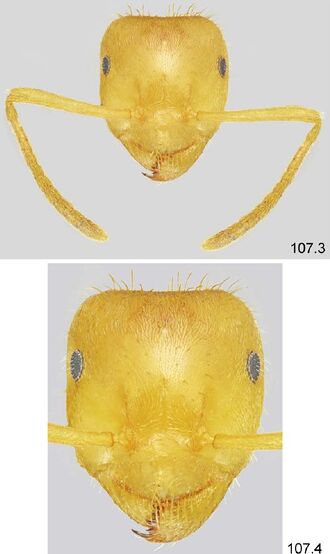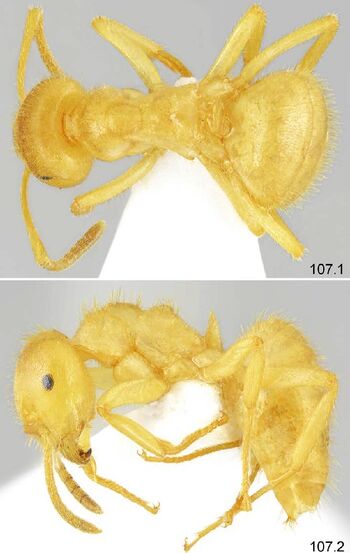Lasius nitidigaster
| Lasius nitidigaster | |
|---|---|

| |
| Scientific classification | |
| Kingdom: | Animalia |
| Phylum: | Arthropoda |
| Class: | Insecta |
| Order: | Hymenoptera |
| Family: | Formicidae |
| Subfamily: | Formicinae |
| Tribe: | Lasiini |
| Genus: | Lasius |
| Section: | flavus clade |
| Species group: | umbratus |
| Species: | L. nitidigaster |
| Binomial name | |
| Lasius nitidigaster Seifert, 1996 | |
A ground nesting species.
Identification
Keys including this Species
Distribution
Latitudinal Distribution Pattern
Latitudinal Range: 46.58444444° to 39.80805556°.
| North Temperate |
North Subtropical |
Tropical | South Subtropical |
South Temperate |
- Source: AntMaps
Distribution based on Regional Taxon Lists
Palaearctic Region: Austria, Bulgaria (type locality), Croatia, Czechia, Greece, Poland, Slovakia, Slovenia, Türkiye.
Distribution based on AntMaps
Distribution based on AntWeb specimens
Check data from AntWeb
Countries Occupied
| Number of countries occupied by this species based on AntWiki Regional Taxon Lists. In general, fewer countries occupied indicates a narrower range, while more countries indicates a more widespread species. |

|
Estimated Abundance
| Relative abundance based on number of AntMaps records per species (this species within the purple bar). Fewer records (to the left) indicates a less abundant/encountered species while more records (to the right) indicates more abundant/encountered species. |

|
Habitat
Borowiec and Salata (2022) - In Greece, recorded from mountain pastures with limestone rocks and pastures close to coniferous forest. Collecting sites noted from mid and high altitude between 790 and 1000 m.
Biology
Fungi
This species is a host for the fungus Aegeritella tuberculata (a pathogen) (Espadaler & Santamaria, 2012).
Castes
Worker
Nomenclature
The following information is derived from Barry Bolton's Online Catalogue of the Ants of the World.
- nitidigaster. Lasius nitidigaster Seifert, 1996b: 185 (w.) [diagnosis in key] BULGARIA. Also decribed as new by Seifert, 1997a: 202 (w.q.m.).
Unless otherwise noted the text for the remainder of this section is reported from the publication that includes the original description.
Description
Worker
Borowiec and Salata (2022) - Monomorphic, moderately large, HL 1.000-1.270, HW 0.984-1.246, ML 1.19-1.62. Scape elongate, SL 0.873-1.159. Color. Whole body including appendages pale yellow. Structure and setation. Head as long as wide to slightly longer than wide, sides rounded, occipital margin straight to slightly concave. Eyes very small, head length at least 7.2 times the maximum diameter of eye. Whole frontal head covered with short, appressed and moderately dense pubescence and sparse, moderately long, erected setae, surface well visible, with diffused microsculpture, shiny. Occipital part of head with 18-24 long erected setae. Gena and underside of head with numerous erected setae. Mesosomal dorsum with several long erected setae, length of the longest seta 0.151. Below propodeal spiracle 2-3 short erected setae. Antennal scapi slightly flattened, on anterior surface with short decumbent pubescence and in apical 2/3 length with suberect hair and few erect setae. Hind tibiae moderately broad and only slightly flattened, with partly decumbent pubescence and 4-12 suberect to erected setae on external surface. Ventral surface of femora with few to several erected setae, anterior surface of fore coxa with few long erected setae. Pubescence on the whole body and appendages short and sparse and whitish, which is smooth and shiny. Pubescence of clypeus sparse, not covering clypeus surface. Surface of gastral tergites with diffused microsculpture, appears smooth and shiny, first gastral tergite on the whole surface with dense and long erected setae. Petiolar scale nearly parallelsided, upper margin with shallow median emargination or occasionally with rounded or truncate upper margin. Propodeum in lateral view moderately high to high, slightly conical with obtuse top, metanotal groove deep.
References
- Borowiec, L. 2014. Catalogue of ants of Europe, the Mediterranean Basin and adjacent regions (Hymenoptera: Formicidae). Genus (Wroclaw) 25(1-2): 1-340.
- Borowiec, L., Salata, S. 2022. A monographic review of ants of Greece (Hymenoptera: Formicidae). Vol. 1. Introduction and review of all subfamilies except the subfamily Myrmicinae. Part 1: text. Natural History Monographs of the Upper Silesian Museum 1: 1-297.
- Csősz, S., Báthori, F., Gallé, L., Lőrinczi, G., Maák, I., Tartally, A., Kovács, É., Somogyi, A.Á., Markó, B. 2021. The myrmecofauna (Hymenoptera: Formicidae) of Hungary: Survey of ant species with an annotated synonymic inventory. Insects 16;12(1):78 (doi:10.3390/insects12010078).
- Czechowski, W., Radchenko, A., Czechowska, W. 2002. The ants (Hymenoptera, Formicidae) of Poland. MIZ PAS Warsaw.
- Espadaler, X., Santamaria, S. 2012. Ecto- and Endoparasitic Fungi on Ants from the Holarctic Region. Psyche Article ID 168478, 10 pages (doi:10.1155/2012/168478).
- Kiran, K., Karaman, C. 2020. Additions to the ant fauna of Turkey (Hymenoptera, Formicidae). Zoosystema 42(18), 285-329 (doi:10.5252/zoosystema2020v42a18).
- Seifert, B. 1996b. Ameisen beobachten, bestimmen. Augsburg: Naturbuch Verlag, 351 pp. (page 185, worker described [diagnosis in key])
- Seifert, B. 1997c. Lasius nitidigaster n. sp. - a new ant of the subgenus Chthonolasius Ruzksy (Hymenoptera: Formicidae). Ann. Zool. (Warsaw) 46: 201-205 (page 202, Also described as new;worker, queen, male described)
References based on Global Ant Biodiversity Informatics
- Borowiec L. 2014. Catalogue of ants of Europe, the Mediterranean Basin and adjacent regions (Hymenoptera: Formicidae). Genus (Wroclaw) 25(1-2): 1-340.
- Borowiec L., and S. Salata. 2012. Ants of Greece - Checklist, comments and new faunistic data (Hymenoptera: Formicidae). Genus 23(4): 461-563.
- Bracko, G. 2006. Review of the ant fauna (Hymenoptera:Formicidae) of Croatia. Acta Entomologica Slovenica 14(2): 131-156.
- Bracko, G.. "Review of the ant fauna (Hymenoptera: Formicidae) of Croatia." Acta Entomologica Slovenica Vol 14 st (2006): 131-156.
- Carniel A. 1998. Ricerche sulla mirmecofauna delle Prealpi Orobiche (Lombardia) (Insecta, Hymenoptera, Formicidae). Atti. Mus. Civ. Stor. Nat. Morbegno 9: 29-39.
- Czechowski W., A. Radchenko, W. Czechowska and K. Vepsäläinen. 2012. The ants of Poland with reference to the myrmecofauna of Europe. Fauna Poloniae 4. Warsaw: Natura Optima Dux Foundation, 1-496 pp
- Lapeva-Gjonova, L., V. Antonova, A. G. Radchenko, and M. Atanasova. "Catalogue of the ants (Hymenoptera, Formicidae) of Bulgaria." ZooKeys 62 (2010): 1-124.
- Lorinczi G. 2011. Lasius (Chthonolasius) nitidigaster Seifert, 1996 -a new ant species (Hymenoptera: Formicidae) for the Hungarian fauna. Natura Somogyiensis 19: 223-228.
- Schar S., G Talavera, X. Espadaler, J. D. Rana, A. A. Andersen, S. P. Cover, and R. Vila. 2018. Do Holarctic ant species exist? Trans-Beringian dispersal and homoplasy in the Formicidae. Journal of Biogeography 00: 1-12.
- Seifert B. 1997. Lasius nitidigaster n. sp. - a new ant of the subgenus Chthonolasius Ruzksy (Hymenoptera: Formicidae). Annales Zoologici (Warsaw) 46: 201-205.
- Steiner F. M., S. Schödl, and B. C. Schlick-Steiner. 2002. Liste der Ameisen Österreichs (Hymenoptera: Formicidae), Stand Oktober 2002. Beiträge zur Entomofaunistik 3: 17-25.
- Vagalinski B., and A. Lapeva-Gjonova. 2012. The ants (Hymenoptera, Formicidae) of Plana Mountain (Bulgaria). Historia naturalis bulgarica 20: 87-101.



